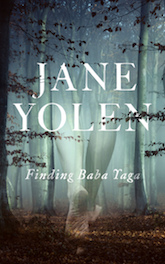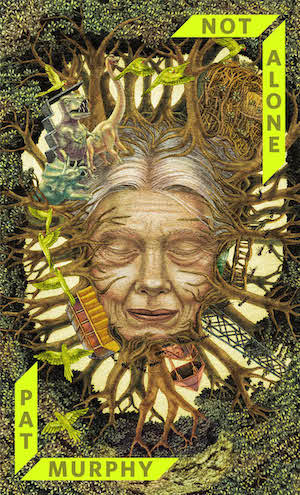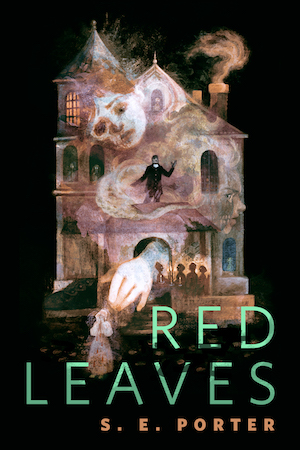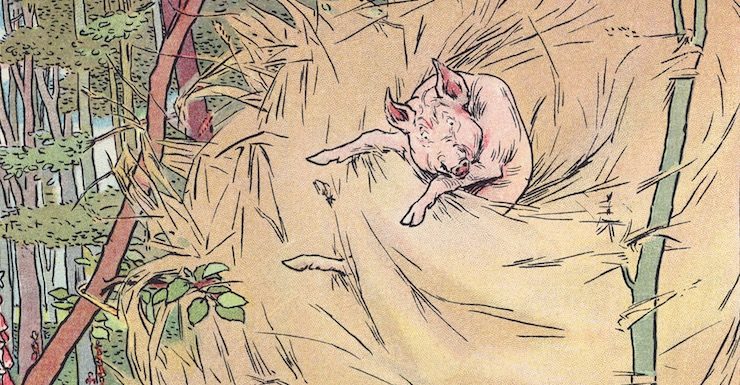Recently, author Chuck Wendig got into a minor spat on Twitter with another Twitter user who insisted that stories do not have to be political. As an example, the Twitter user mentioned “The Three Little Pigs.”
My screams probably could have heard on the other side of the ocean.
So, even though Chuck Wendig already did a good job of explaining just why this story is perhaps not the best example of non-political storytelling, I thought it might be worthwhile to take a more in depth look at the tale here and its history. Even though I HATE THIS STORY. And even though many early versions don’t even MENTION pigs at all…
First, a general note: fairy tales are inherently political. Indeed, in many cases, authors deliberately chose fairy tale subjects in the hopes of making political points—sometimes subtly, sometimes obviously so, in the case of some satirical fairy tales. Broadly speaking, I tend to classify them into one or more categories:
- The expressly political: fairy tales and collections intended to accomplish some sort of political purpose—restore and celebrate German culture after the humiliation of the Napoleonic Wars, and argue for a unified Germany, for example, or stories that satirize current political structures. Examples include: the Grimm collections, Hans Christian Andersen’s “The Emperor’s New Clothes,” the Asbjørnsen and Moe collections, and the tales of Anne Isabella Thackeray Ritchie.
- The subversively political: fairy tales used to obliquely criticize repressive regimes, using fairy tale structures and motifs, usually in an attempt to avoid imprisonment or execution. (Spoiler: this was not always successful.) Examples include: nearly all of the French salon fairy tales, James Thurber’s fables.
- The accidentally political: fairy tales that, although not necessarily written with any political intent in mind, still ended up either reflecting or reinforcing contemporary attitudes, or, by simply being collected, serving as incidental comments on what cultural elements the collector/translator felt was worth sharing and presenting—itself political. Examples include: many of the versions of Jack and the Beanstalk, some of Andersen’s tales, most of the Andrew Lang collections, James Thurber’s The 13 Clocks.
These are not, of course, particularly hard and fast categories. Indeed, many fairy tales and collections tending to fall into more than one category—such as the work of Giambiattista Basile, whose primary purpose was to advance Neopolitan language and culture and argue that it was superior to other cultures (expressly political), but whose personal negative experiences and opinions on Italian aristocrats could not help but seep through his brutal, sadistic, and frequently over the top tales (subversively political) and who also incidentally included details about land use, attitudes towards servants and laborers, and racial issues during his time (accidentally political).
So how does “The Three Little Pigs” fall into this? Well, here’s where things get a bit complicated—largely because, like many fairy tales, “The Three Little Pigs” exists in multiple versions, some with pigs, some without pigs, some with a bunny. (A very specific bunny.) And those versions tended to be published or filmed for different reasons—sometimes to entertain children, sometimes as part of folklore studies, or as arguments for a reconsideration of environmental land use, or as an experiment in animation, or as a satire on another animation studio, with a touch of “You spent how much on Fantasia, Walt? Really?” or an attempt to reproduce another animation studio’s financial success, with a touch of “You made how much on that cartoon short, Walt? Really?”
One of the earliest recorded versions, appearing in two different nineteenth century sources, illustrates these complications. Probably from the Dartmoor region, it does not actually have any pigs. Instead, it focuses on pixies and foxes. A hungry fox, out on the prowl, finds a colony of pixies. He is able to tear down the first house—one made of wood—and eat the pixy hiding inside. And even the second, a “stonen” house. (The term, for fellow confused American readers, is a fancy Dartmoor word for “stone”; a quick Google search will show several examples of stonen houses, though readers are warned that this search may lead to an unquenchable desire to purchase a nice English countryside house, regardless of your budget restrictions.) One would think that two pixies would be enough to satisfy the hunger of any fox, but as in most fairy tales, things come in threes, and the fox wants to eat a third pixie. This one lives in an iron house—an unusual sort of dwelling for a fairy creature, I would think, since folklore assures me that they prefer to avoid iron—but one that turns out to be fairly useful for the pixy, since although the fox is able to destroy houses of stone, the iron house is beyond him.
Denied his tasty pixy treat, the fox then tries to trick the pixy—with one trick including turnips and a turnip field, a motif that would reappear in later versions of the tale. All of his tricks fail, but after the third try, the fox is finally able to capture the pixy in bed, and place him into a box; the pixy is only able to escape by promising to tell the fox a wonderful secret, and then placing a spell on the fox. It’s not at all clear why the pixy waited until after a targeted harassment campaign and the death of his two fellow pixies to act, but maybe this was the sort of pixy who didn’t like other pixies very much and figured that having a fox stalking around playing tricks was the best way to ensure a pixy life of solitude and plenty of turnips. Or I am projecting. You decide.
Political? Oh, certainly—in more than one sense. The story itself functions as a complaint about the quality of houses available in England during the early 19th century and earlier, making a not particularly subtle point about the dangers inherent in low quality homes. And, of course, it offers a warning to those trying to prey on the unfortunates living in those houses: at some point, the tables could be turned. The various European revolutions of 1848 were still in vivid living memory when this story made its first printed appearance in 1853, in the anonymous in English Forests and Forest Trees: Historical, Legendary and Descriptive.
But the anonymous writers and editors were not merely interested in veiled warnings about economic revolutions. They had another political use for this tale. As the introduction to this collection notes, English forests were rapidly disappearing thanks to urban development, enclosures, and farming, all serious economic and political issues in 1853. The changes distressed the tree-loving, anonymous editors, who used the book to argue that losing England’s forests did not just mean losing trees, but losing a critical part of the country’s history, culture and strength. As part of that argument, they used this tale as an example of the rich folklore inspired by English forests, and as an example of why these forests needed to be preserved—contrary to the policies of the British government.
Thus, the very first published version of the tale of “The Three Little Pigs” was in an explicitly political text, used as an argument against current land practices.
The story made another pigless appearance in volume 8 of Frazer’s Magazine, published in 1873, edited by historian James Anthony Froude (1818-1894) and theologian John Tulloch (1823-1886). The initially conservative journal had a rich literary history, renowned for publishing such luminaries as Samuel Taylor Coleridge, William Makepiece Thackeray, and John Stuart Mill, as well as lesser known writers and the occasional woman such as Janet Ross (probably best known to U.S. readers as an early author of cookbooks and as Mark Twain’s neighbor when he was living in Italy), when Froude took over as its editor in 1860.
Froude, called “an impressive, if intermittently appalling personality” by The Times Literary Supplement, had a major influence on 19th century literature and historiography. But as his recent biographer Ciaran Brody has noted, he has been largely forgotten these days by everyone except The Times Literary Supplement and scholars of 19th century British literature. Trained in Oxford for a religious career, Froude soon grew to have grave doubts about both the Anglican and Catholic churches, which forced him out of the church hierarchy in 1849. As a still ordained deacon, however, he could not pursue his next interest, professional politics—though that did not deter him from meddling and commenting in politics when he felt the need, which was often.
Instead, he turned to a career as a professional historian and novelist. Here, Froude at least found financial success. All twelve volumes of his monumental History of England from the Fall of Wolsey to the Death of Elizabeth (currently available for the Kindle and on various websites) sold briskly. Critical success, however, eluded him. Fellow historians found fault with a number of his historical interpretations, and his novels tended to be more criticized than praised. He ran into particular controversy when trying to write a biography of his friend Thomas Carlyle; his decision to publish some of Thomas Carlyle’s papers without full authorization from the family caused outrage.
When not writing, he indulged his love of travel, sometimes financing this with paid lecture tours, to mixed success. This included trips throughout the British Empire and its various possessions, where he frequently commented on and meddled with politics and international affairs. Froude may have doubted certain aspects of the Anglican Church; he had few if any doubts about British imperialism and white supremacy. At one point, he argued for implementing a forced labor system on South African blacks and confiscating their lands; fellow whites accused him of plotting and agitating for racial extermination. In a later book, The English in the West Indies (1888), he argued that Jamaica, Trinidad, and other British Caribbean possessions could not be granted home rule, since this would inevitably lead to the election of black leaders who would repress the white population, and also contained several racist comments. Both white and black readers in the Caribbean expressed outrage.
Buy the Book


Finding Baba Yaga: A Short Novel in Verse
His fellow editor John Tulloch had a much less contentious career. After studying at the University of St. Andrews and the University of Edinburgh, he quietly entered the Church, and equally quietly churned out theological studies and biographical sketches of religious leaders, while teaching theology and comparative religion. By 1854, he was a professor of theology at St. Andrews. His general position—supportive enough of the Established Church to be allowed to preach in front of Queen Victoria, generally tolerant of other religious ideas—could hardly have been further from Froude’s. This may help explain why Tulloch does not seem to have done all that much editing work at Frazer’s, and why although John Tulloch is credited as the editor of some of the articles in this particular volume of the zine, Froude’s name is the one prominently on the cover.
The story of the pixies and the fox appears in an article on “The Folk-Lore of Devonshire.” It does not have a byline, and may have been the work of either Tulloch or Froude. More likely, given the subject matter, Tulloch. But the final decision to include it was probably made by the racist, pro-imperialist Froude—who recognized the article for what it was: an argument for the antiquity and superiority of the folklore of Devonshire, credited to “one of the best possible backgrounds for ‘a tale of ghosts and spirits'”, focusing on the power of the ancient moor, and noting the entire area as a stronghold of old tradition. The word choices are all, without exception, positive: the story of the pixies was not just a nice fable about choosing the correct building materials, or even an interesting look at pixie culture, but a way to demonstrate the antiquity and superiority of British culture, as a justification for the (in Froude’s mind) benign, benevolent rule of the British Empire.
That is, political.
And also, boring and almost forgotten.
Because, as it turns out, burying stories about pixies and foxes in lengthy texts about British forestry practices and scholarly discussions about the cultural superiority of Devonshire? Not the best way to create popular fairy tales. I shock you. I know.
So how did this story enter the popular imagination—and where, I hear you ask, are the pigs?
Coming up next.
Mari Ness lives in central Florida.on fairy










